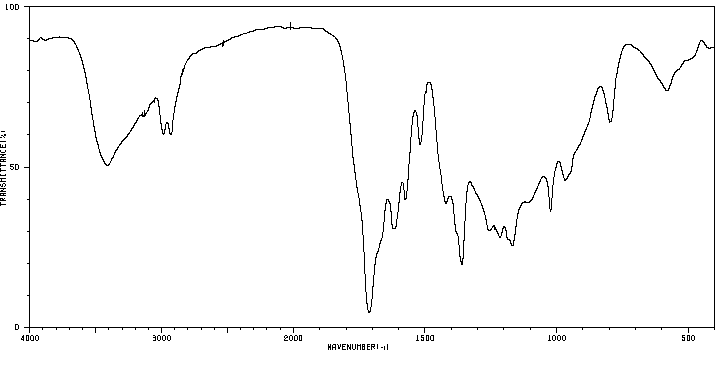4-(5-methyl-2-furanyl)-3-buten-2-one | 23120-57-2
中文名称
——
中文别名
——
英文名称
4-(5-methyl-2-furanyl)-3-buten-2-one
英文别名
4-(5-methylfuran-2-yl)but-3-en-2-one;1-(5-methylfur-2-yl)-buten-3-one;5-Methylfurfurylideneacetone
CAS
23120-57-2
化学式
C9H10O2
mdl
MFCD03450520
分子量
150.177
InChiKey
FKNBELIGEMXLJS-UHFFFAOYSA-N
BEILSTEIN
——
EINECS
——
-
物化性质
-
计算性质
-
ADMET
-
安全信息
-
SDS
-
制备方法与用途
-
上下游信息
-
文献信息
-
表征谱图
-
同类化合物
-
相关功能分类
-
相关结构分类
物化性质
-
熔点:35-36 °C
-
沸点:124 °C(Press: 12 Torr)
-
密度:1.049±0.06 g/cm3(Predicted)
计算性质
-
辛醇/水分配系数(LogP):1.5
-
重原子数:11
-
可旋转键数:2
-
环数:1.0
-
sp3杂化的碳原子比例:0.22
-
拓扑面积:30.2
-
氢给体数:0
-
氢受体数:2
SDS
上下游信息
-
上游原料
中文名称 英文名称 CAS号 化学式 分子量 —— 4-(5-(hydroxymethyl)furan-2-yl)but-3-en-2-one —— C9H10O3 166.177
反应信息
-
作为反应物:描述:4-(5-methyl-2-furanyl)-3-buten-2-one 在 acetonitrile(4′-phenyl-2,2′:6′,2”-terpyridine)(8-quinolinethiolate)ruthenium(II) triflate 、 氢气 作用下, 以 水 为溶剂, 200.0 ℃ 、5.5 MPa 条件下, 反应 16.0h, 以29%的产率得到nonane-2,5,8-triol参考文献:名称:Ruthenium-8-quinolinethiolate-phenylterpyridine versus ruthenium-bipyridine-phenyl-terpyridine complexes as homogeneous water and high temperature stable hydrogenation catalysts for biomass-derived substrates摘要:[(4'-Ph-terpy)(bipy)Ru(L)](OTf)(n) and [(4'-Ph-terpy)(quS)Ru(L)](OTf)(n) (n = 0 or 1 depending on the charge of L, L = labile ligand, e.g., H2O, CH3CN or OTf, bipy = 2,2'-bipyridine, quS = quinoline-8-thiolate) have been evaluated as catalysts for the hydrogenation of the biomass-derivable C6-substrates 2,5-dimethylfuran (obtainable from 5-hydroxymethylfurfural) and 2,5-hexanedione (the hydrolysis product of 2,5-dimethylfuran). Operating in aqueous acidic medium at T = 175-225 degrees C the bipy complex is only marginally active, while the quinoline-8-thiolate complex realizes yields of hydrogenated products up to 97% starting from 2,5-hexanedione and up to 66% starting from 2,5-dimethylfuran. The catalyst can also convert the 5-HMF derived acetone 4-(5-methyl-2-furanyl)-3-buten-2-one into 2,5,8-nonatriol, a potentially valuable cross-linker for polymer formulations. On the basis of DFT calculations, the higher activity of the quinoline-8-thiolate complex is proposed to be rooted in a metal-ligand bifunctional mechanism for the heterolytic activation and transfer of dihydrogen to the carbonyl substrate with the hydride-thiol complex [(4'-Ph-terpy)(quSH)Ru(H)r as the active catalyst. (C) 2015 Elsevier Ltd. All rights reserved.DOI:10.1016/j.poly.2015.10.049
-
作为产物:描述:hydroxymethylfurfural 在 哌啶 、 盐酸 、 magnesium 作用下, 以 四氢呋喃 、 甲醇 、 水 为溶剂, 反应 24.0h, 生成 4-(5-methyl-2-furanyl)-3-buten-2-one参考文献:名称:生物质衍生的呋喃环的酸催化开环的官能团依赖性:实验和理论研究†摘要:我们描述了布朗斯台德酸催化生物质衍生的C 8和C 9分子中包含的取代呋喃的开环研究。在80°C的相对温和条件下,使用催化盐酸。如果是4-(5-甲基-2-呋喃基)-2-丁酮(1a),反应在24小时后以高达92%的产率进行到单一产物。为了4-(2-呋喃基)-2-丁酮(1b)和4-(5-羟甲基)-2-呋喃基-2-丁酮(1c),但是,观察到多种产物,说明呋喃环取代基对此类化合物的反应性有重大影响。使用其他几种相似的底物测试了这些反应途径的一般性。动力学实验表明1a的开环是通过特定的酸催化而发生的,计算结果阐明了初始质子化对反应路径的影响。相对于实验测量值校准计算的p K a值,并与观察到的反应性一致。包含明确的氢键键合水 在研究醇和酮基的质子化时,除了SMD溶剂模型外,还需要其他分子。DOI:10.1039/c2cy20395b
文献信息
-
[EN] COMPOUNDS AND METHODS FOR THE PRODUCTION OF LONG CHAIN HYDROCARBONS FROM BIOLOGICAL SOURCES<br/>[FR] COMPOSÉS ET PROCÉDÉS DE PRODUCTION D'HYDROCARBURES À CHAÎNE LONGUE À PARTIR DE SOURCES BIOLOGIQUES申请人:LOS ALAMOS NAT SECURITY LLC公开号:WO2013040311A1公开(公告)日:2013-03-21The present invention is directed to the preparation of oxygenated, unsaturated hydrocarbon compounds, such as derivatives of furfural or hydroxymethyl furfural produced by aldol condensation with a ketone or a ketoester, as well as methods of deoxidatively reducing those compounds with hydrogen under acidic conditions to provide saturated hydrocarbons useful as fuels.
-
The hydrodeoxygenation of bioderived furans into alkanes作者:Andrew D. Sutton、Fraser D. Waldie、Ruilian Wu、Marcel Schlaf、Louis A. ‘Pete’ Silks、John C. GordonDOI:10.1038/nchem.1609日期:2013.5The conversion of biomass into fuels and chemical feedstocks is one part of a drive to reduce the world's dependence on crude oil. For transportation fuels in particular, wholesale replacement of a fuel is logistically problematic, not least because of the infrastructure that is already in place. Here, we describe the catalytic defunctionalization of a series of biomass-derived molecules to provide linear alkanes suitable for use as transportation fuels. These biomass-derived molecules contain a variety of functional groups, including olefins, furan rings and carbonyl groups. We describe the removal of these in either a stepwise process or a one-pot process using common reagents and catalysts under mild reaction conditions to provide n-alkanes in good yields and with high selectivities. Our general synthetic approach is applicable to a range of precursors with different carbon content (chain length). This allows the selective generation of linear alkanes with carbon chain lengths between eight and sixteen carbons. The development of methodology to convert biomass into fuels and chemical feedstocks is part of a drive to reduce the world's dependence on crude oil. Here, the catalytic defunctionalization of a series of biomass-derived molecules is described, which allows the selective generation of alkanes with carbon chain lengths between eight and sixteen for use as transportation fuels.将生物质转化为燃料和化工原料是减少世界对原油依赖的举措之一。特别是对于运输燃料,整体替代燃料在物流上存在问题,尤其是因为现有基础设施的存在。在这里,我们描述了一系列生物质衍生分子的催化去功能化过程,以提供适合用作运输燃料的直链烷烃。这些生物质衍生分子包含各种官能团,包括烯烃、呋喃环和羰基。我们描述了在温和反应条件下,使用常见试剂和催化剂分步或一步工艺去除这些官能团,以提供高产率和高选择性的正烷烃。我们的一般合成方法适用于具有不同碳含量(链长)的一系列前体。这允许选择性地生成碳链长度在8到16个碳之间的直链烷烃。开发将生物质转化为燃料和化工原料的方法是减少世界对原油依赖的举措之一。在这里,描述了一系列生物质衍生分子的催化去功能化过程,这允许选择性地生成用作运输燃料的碳链长度在8到16之间的烷烃。
-
Towards Improved Biorefinery Technologies: 5‐Methylfurfural as a Versatile C <sub>6</sub> Platform for Biofuels Development作者:Konstantin I. Galkin、Valentine P. AnanikovDOI:10.1002/cssc.201802126日期:2019.1.10Low chemical stability and high oxygen content limit utilization of the bio‐based platform chemical 5‐(hydroxymethyl)furfural (HMF) in biofuels development. In this work, Lewis‐acid‐catalyzed conversion of renewable 6‐deoxy sugars leading to formation of more stable 5‐methylfurfural (MF) is carried out with high selectivity. Besides its higher stability, MF is a deoxygenated analogue of HMF with increased
-
一种基于生物质化学品合成功能化1,3-丁二烯的方法
-
一种有效抑制或杀灭多重耐药细菌的化合物 及其制备方法与应用
表征谱图
-
氢谱1HNMR
-
质谱MS
-
碳谱13CNMR
-
红外IR
-
拉曼Raman
-
峰位数据
-
峰位匹配
-
表征信息
同类化合物
香薷二醇
顺式-1-(2-呋喃基)-1-戊烯
顺-1,2-二氰基-1,2-双(2,4,5-三甲基-3-噻吩基)乙烯
顺-1,2-(2-噻嗯基)二乙烯
雷尼替丁-N,S-二氧化物
雷尼替丁-N-氧化物
钴(II)双[(2-吡啶基甲基)(叔丁基二甲基甲硅烷基)酰胺]
西拉诺德
螺[环氧乙烷-2,3'-吡咯并[1,2-a]吡嗪]
萘并[2,1,8-def]喹啉
苯硫基溴化镁
苯甲酸,2-[[[7-[[(3.β.)-3-羟基-28-羰基羽扇-20(29)-烯-28-基]amino]庚基]氨基]羰基]
苍术素
羟胺,O-[4-(2-呋喃基)丁基]-
缩水甘油糠醚
紫苏烯
糠醛肟
糠醛氰醇的1-乙氧基乙基醚
糠醇-d2
糠醇
糠基硫醇-d2
糠基硫醇
糠基甲基硫醚
糠基氯
糠基氨基甲酸异丙酯
糠基丙基醚
糠基丙基二硫醚
糠基3-巯基-2-甲基丙酸酯
糠基-异戊基醚
糠基-异丁基醚
糠基 2-甲基-3-呋喃基二硫醚
磷杂茂
碘化N,N,N-三甲基丁烷-1-铵
硫酸异丙基糠酯
硫代磷酸O-糠基O-甲基S-(2-丙炔基)酯
硫代磷酸O-乙基O-糠基S-(2-丙炔基)酯
硫代甲酸S-糠酯
硫代噻吩甲酰基三氟丙酮
硫代乙酸糠酯
硫代丙酸糠酯
硒吩-3-羧酸酰肼
硅烷,三(1-甲基乙基)[(3-甲基-2-呋喃基)氧代]-
硅烷,[2-(3-呋喃基)乙烯基]三甲基-,(E)-
硅烷,(1,1-二甲基乙基)(2-呋喃基甲氧基)二甲基-
砷杂苯
甲酸糠酯
甲氧亚胺基呋喃乙酸铵盐
甲基糠基醚
甲基糠基二硫
甲基呋喃-2-基甲基氨基甲酸酯







